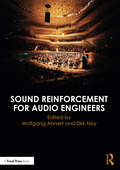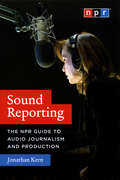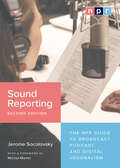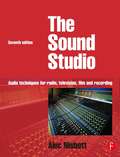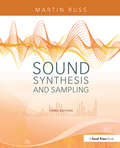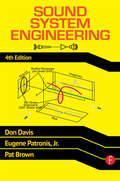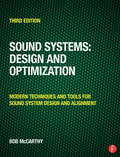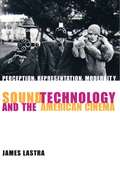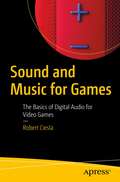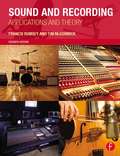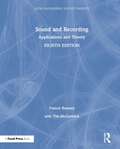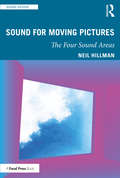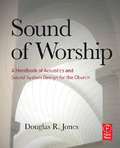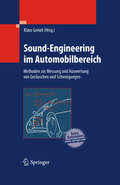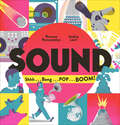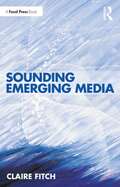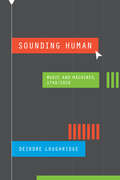- Table View
- List View
Sound Reinforcement for Audio Engineers
by Wolfgang AhnertSound Reinforcement for Audio Engineers illustrates the current state of the art in sound reinforcement. Beginning with an outline of various fields of applications, from sports venues to religious venues, corporate environments and cinemas, this book is split into 11 chapters covering room acoustics, loudspeakers, microphones and acoustic modelling among many other topics. This comprehensive book packed with references and a historical overview of sound reinforcement design is an essential reference book for students of acoustics and electrical engineering, but also for engineers looking to expand their knowledge of designing sound reinforcement systems.
Sound Reporting
by Jonathan KernPerhaps you've always wondered how public radio gets that smooth, well-crafted sound. Maybe you're thinking about starting a podcast, and want some tips from the pros. Or maybe storytelling has always been a passion of yours, and you want to learn to do it more effectively. Whatever the case--whether you're an avid NPR listener or you aspire to create your own audio, or both--Sound Reporting: The NPR Guide to Audio Journalism and Production will give you a rare tour of the world of a professional broadcaster. Jonathan Kern, who has trained NPR's on-air staff for years, is a gifted guide, able to narrate a day in the life of a host and lay out the nuts and bolts of production with equal wit and warmth. Along the way, he explains the importance of writing the way you speak, reveals how NPR books guests ranging from world leaders to neighborhood newsmakers, and gives sage advice on everything from proposing stories to editors to maintaining balance and objectivity. Best of all--because NPR wouldn't be NPR without its array of distinctive voices--lively examples from popular shows and colorful anecdotes from favorite personalities animate each chapter. As public radio's audience of millions can attest, NPR's unique guiding principles and technical expertise combine to connect with listeners like no other medium can. With today's technologies allowing more people to turn their home computers into broadcast studios, Sound Reporting couldn't have arrived at a better moment to reveal the secrets behind the story of NPR's success.
Sound Reporting, Second Edition: The NPR Guide to Broadcast, Podcast and Digital Journalism
by Jerome SocolovskyAn indispensable guide to audio journalism grounded in NPR’s journalistic values and practices, with tips and insights from its top reporters, hosts, editors, producers, and more. A lot has changed in media in recent years, but one thing that remains steadfast is National Public Radio’s (NPR) position as a trusted source of news in the United States. Now producing dozens of shows and podcasts, plus livestreams and coverage on other media platforms, NPR is the leading authority on reporting, writing, and delivering audio news and storytelling to today's diverse audiences. In this completely revised guide, audio journalism trainer Jerome Socolovsky offers a look into just how NPR does it, following the same journey a story would from idea to the moment it reaches its listeners. Based on more than eighty interviews with producers, reporters, editors, hosts, and other NPR staffers, Sound Reporting reveals how stories get pitched; how they are reported, produced, written, edited, voiced, and tailored to multiple media formats; and how shows and podcasts are put together. It begins with a presentation of NPR's values and includes a new chapter on journalist safety, a topic of timely importance. Podcasts, now part of the mainstream of the media universe, are treated alongside traditional programs throughout. In these pages, the voices of NPR staff offer a glimpse into their profession. Discover how correspondent Ruth Sherlock overcame seemingly insurmountable odds as she raced to the scene of a devastating earthquake in Turkey, the four main ways Ramtin Arablouei incorporates music into podcasts, and how “Weekend Edition” host Ayesha Rascoe touches listeners so deeply she received a pair of homemade potholders in the mail from one of them. Reading this book is like sitting in a room full of top-notch producers, seasoned correspondents, trusted hosts, and rigorous editors—all telling you inspiring stories about their craft to help you learn from their experience. At a time when the legitimacy and authority of journalism are under critique, transparency into how the news is made is more important than ever. This book offers a fascinating look behind the scenes at a premier public media organization and will be a trusted resource for anyone in or exploring a future in audio journalism.
Sound Reporting: The NPR Guide to Audio Journalism and Production
by Jonathan KernPerhaps you’ve always wondered how public radio gets that smooth, well-crafted sound. Maybe you’re thinking about starting a podcast, and want some tips from the pros. Or maybe storytelling has always been a passion of yours, and you want to learn to do it more effectively. Whatever the case—whether you’re an avid NPR listener or you aspire to create your own audio, or both—Sound Reporting: The NPR Guide to Audio Journalism and Production will give you a rare tour of the world of a professional broadcaster. <p><p> Jonathan Kern, who has trained NPR’s on-air staff for years, is a gifted guide, able to narrate a day in the life of a host and lay out the nuts and bolts of production with equal wit and warmth. Along the way, he explains the importance of writing the way you speak, reveals how NPR books guests ranging from world leaders to neighborhood newsmakers, and gives sage advice on everything from proposing stories to editors to maintaining balance and objectivity. Best of all—because NPR wouldn’t be NPR without its array of distinctive voices—lively examples from popular shows and colorful anecdotes from favorite personalities animate each chapter. <p> As public radio’s audience of millions can attest, NPR’s unique guiding principles and technical expertise combine to connect with listeners like no other medium can. With today’s technologies allowing more people to turn their home computers into broadcast studios, Sound Reporting couldn’t have arrived at a better moment to reveal the secrets behind the story of NPR’s success.
Sound Reproduction: The Acoustics and Psychoacoustics of Loudspeakers and Rooms (Audio Engineering Society Presents)
by Floyd E. TooleSound Reproduction: The Acoustics and Psychoacoustics of Loudspeakers and Rooms, Third Edition explains the physical and perceptual processes that are involved in sound reproduction and demonstrates how to use the processes to create high-quality listening experiences in stereo and multichannel formats. Understanding the principles of sound production is necessary to achieve the goals of sound reproduction in spaces ranging from recording control rooms and home listening rooms to large cinemas. This revision brings new science-based perspectives on the performance of loudspeakers, room acoustics, measurements and equalization, all of which need to be appropriately used to ensure the accurate delivery of music and movie sound tracks from creators to listeners. The robust website (www.routledge.com/cw/toole) is the perfect companion to this necessary resource.
Sound Studio: Audio techniques for Radio, Television, Film and Recording (Library Of Communication Techniques Ser.)
by Alec NisbettThis classic work has inspired and informed a whole generation of artists and technicians working in all branches of the audio industry. Now in its seventh edition, The Sound Studio has been thoroughly revised to encompass the rapidly expanding range of possibilities offered by today's digital equipment. It now covers: the virtual studio; 5.1 surround sound; hard drive mixers and multichannel recorders; DVD and CD-RW.Alec Nisbett provides encyclopaedic coverage of everything from acoustics, microphones and loudspeakers, to editing, mixing and sound effects, as well as a comprehensive glossary.Through its six previous editions, The Sound Studio has been used for over 40 years as a standard work of reference on audio techniques. For a new generation, it links all the best techniques back to their roots: the unchanging guiding principles that have long been observed over a wide range of related media and crafts. The Sound Studio is intended for anyone with a creative or technical interest in sound - for radio, television, film and music recording - but has particularly strong coverage of audio in broadcasting, reflecting the author's prolific career.
Sound Synthesis and Sampling: An Interactive Database Of Audio Examples, Animated Diagrams, Text Notes And Multiple Choice Questions (Music Technology Ser.)
by Martin RussSound Synthesis and Sampling' provides a comprehensive introduction to the underlying principles and practical techniques applied to both commercial and research sound synthesizers. This new edition has been updated throughout to reflect current needs and practices- revised and placed in a modern context, providing a guide to the theory of sound and sampling in the context of software and hardware that enables sound making. For the revised edition emphasis is on expanding explanations of software and computers, new sections include techniques for making sound physically, sections within analog and digital electronics. Martin Russ is well known and the book praised for its highly readable and non-mathematical approach making the subject accessible to readers starting out on computer music courses or those working in a studio.
Sound System Engineering 4e
by Pat Brown Don Davis Eugene PatronisLong considered the only book an audio engineer needs on their shelf, Sound System Engineering provides an accurate, complete and concise tool for all those involved in sound system engineering. Fully updated on the design, implementation and testing of sound reinforcement systems this great reference is a necessary addition to any audio engineering library.Packed with revised material, numerous illustrations and useful appendices, this is a concentrated capsule of knowledge and industry standard that runs the complete range of sound system design from the simplest all-analog paging systems to the largest multipurpose digital systems.
Sound Systems: Modern Techniques and Tools for Sound System Design and Alignment
by Bob McCarthySound Systems: Design and Optimization provides an accessible and unique perspective on the behavior of sound systems in the practical world. The third edition reflects current trends in the audio field thereby providing readers with the newest methodologies and techniques. In this greatly expanded new edition, you’ll find clearer explanations, a more streamlined organization, increased coverage of current technologies and comprehensive case studies of the author’s award-winning work in the field. As the only book devoted exclusively to modern tools and techniques in this emerging field, Sound Systems: Design and Optimization provides the specialized guidance needed to perfect your design skills. This book helps you: Improve your design and optimization decisions by understanding how audiences perceive reinforced sound Use modern analyzers and prediction programs to select speaker placement, equalization, delay and level settings based on how loudspeakers interact in the space Define speaker array configurations and design strategies that maximize the potential for spatial uniformity Gain a comprehensive understanding of the tools and techniques required to generate a design that will create a successful transmission/reception model
Sound Technology and the American Cinema: Perception, Representation, Modernity (Film and Culture Series)
by James LastraRepresentational technologies including photography, phonography, and the cinema have helped define modernity itself. Since the nineteenth century, these technologies have challenged our trust of sensory perception, given the ephemeral unprecedented parity with the eternal, and created profound temporal and spatial displacements. But current approaches to representational and cultural history often neglect to examine these technologies. James Lastra seeks to remedy this neglect.Lastra argues that we are nowhere better able to track the relations between capital, science, and cultural practice than in photography, phonography, and the cinema. In particular, he maps the development of sound recording from its emergence to its confrontation with and integration into the Hollywood film.Reaching back into the late eighteenth century, to natural philosophy, stenography, automata, and human physiology, Lastra follows the shifting relationships between our senses, technology, and representation.
Sound Waves and Acoustic Emission (Synthesis Lectures on Wave Phenomena in the Physical Sciences)
by Claudia Barile Caterina Casavola Giovanni Pappalettera Vimalathithan Paramsamy KannanThe nature of sound is, nowadays, well known and understood so that sound could be synthetically described like the propagation of vibration in elastic media.Sound waves propagate as longitudinal waves, transverse waves, or in mixed modes in different media. The development of applications related to the proper management of the information connected with sound waves. This is the case of so-called acoustic emission. This book introduces the basics of sound waves, their types, propagation in different modes, velocities, and other properties It also introduces the basics of acoustic emission and the different sources of acoustic emission. This book delivers different propagation modes, their significance, and the attenuation and distortion of acoustic waves. One of the overlooked applications of acoustic emission, the acousto-ultrasonic approach is introduced and discussed with practical applications.
Sound and Music for Games: The Basics of Digital Audio for Video Games
by Robert CieslaGrasp the fundamentals of digital audio work in the context of video games, including the basics of middleware such as Fmod and Wwise. We will review software such as Apple's Logic and Garageband, Paul Davis's Ardour, and many other popular digital audio workstations. We will start with an introduction to the basic terminology of digital audio work while also getting acquainted with current generation audio hardware. We will then discuss the basics of the venerable Musical Instrument Digital Interface (MIDI) and how it relates to music composition as well as the tools and techniques for writing tracker music/chiptunes. The book also covers plug-in software, soundproofing at home, and voice work. The book takes a practical approach while tackling both hardware and software components used in cutting edge audio engineering, composition, and audio monitoring. What You Will Learn • Understand the fundamentals of digital audio production in the context of video games • Learn about audio integration with popular middleware solutions and APIs • Leverage plugin effects software to sculpt your audio to professional levels • Identify modern audio file formats and how and when to use them • Learn best practices when mixing sound effects and music for video games Who Is This Book For The intended readership includes beginners in digital audio engineering who use Windows, macOS, or Linux.
Sound and Recording: Applications and Theory (Focal Press Music Technology Ser.)
by Francis Rumsey Tim MccormickProviding vital reading for audio students and trainee engineers, this guide is ideal for anyone who wants a solid grounding in both theory and industry practices in audio, sound and recording. There are many books on the market covering "how to work it" when it comes to audio equipment--but Sound and Recording isn't one of them. Instead, you'll gain an understanding of "how it works" with this approachable guide to audio systems. New to this edition: Digital audio section revised substantially to include the latest developments in audio networking (e.g. RAVENNA, AES X-192, AVB), high-resolution surround and parametric audio coding, workstation processing technology, mastering for iTunes, and loudness normalization Coverage of immersive audio systems such as Dolby Atmos, Auro 3D and WFS along with recent developments in audio object coding Sections on digital radio microphones, loudspeaker sensitivity issues and development, and highly directional loudspeaker systems Substantial new sections on recent developments in audio network device discovery and control and the Open Control Architecture
Sound and Recording: Applications and Theory (ISSN)
by Francis RumseyProviding vital reading for audio students and trainee engineers, Sound and Recording is the essential guide for anyone who wants a solid grounding in both theory and industry practices in audio, sound, and recording. This updated and comprehensively restructured edition includes new content on DAW configuration, effects processing, 3D/immersive audio systems, object-based audio, and VR audio technology.This bestselling book introduces you to the principles of sound, perception, audio technology, and systems. Sound and Recording is the ideal audio engineering text for students, an accessible reference for professionals, and a comprehensive introduction for hobbyists.
Sound and Robotics: Speech, Non-Verbal Audio and Robotic Musicianship
by Richard SaverySound in human–robot interaction currently encompasses a wide range of approaches and methodologies not easily classified, analyzed or compared among projects. This edited book covers the state of the art in sound and robotics, aiming to gather existing approaches in a combined volume. Collecting chapters from world-leading academic and industry authors, Sound and Robotics: Speech, Non-Verbal Audio and Robotic Musicianship explores how robots can communicate through speech, non-verbal audio and music. The first set of chapters explores how robots use verbal communication, considering the possibilities of speech for human–robot interaction. The second section shifts to roles of non-verbal communication in HRI, including consequential sound, sonification and audio cues. The third and final section describes current approaches to robotic musicianship and their evaluation. This book is primarily aimed at HRI researchers, ranging from those who have never used sound to those very experienced with sound. Alongside robotic researchers, this book will present avenues for a diverse range of musicians, composers and sound designers to become introduced to the world of HRI and learn of potential creative directions in robotics.
Sound and Vibrations of Positive Displacement Compressors
by Werner SoedelBased on more than 30 years of research and practical experience, this book is the first to combine theory and design guidelines dedicated solely to positive displacement compressors. After introducing the sound- and vibration-producing mechanisms common to different types of compressors, the author discusses free and forced vibrations of compressor housing shells, mainly for hermetically sealed compressors. He then examines vibration in casings and other components, such as suction and discharge tubes, and surging in coil springs. Detailed chapters explore the design and vibrations of automatic plate or reed valves as well as the analysis and design of suction and discharge mufflers.
Sound for Moving Pictures: The Four Sound Areas (Sound Design)
by Neil HillmanSound for Moving Pictures presents a new and original sound design theory called the Four Sound Areas framework, offering a conceptual template for constructing, deconstructing and communicating all types of motion picture soundtracks; and a way for academics and practitioners to better understand and utilize the deeper, emotive capabilities available to all filmmakers through the thoughtful use of sound design. The Four Sound Areas framework presents a novel approach to sound design that enables the reader to more fully appreciate audience emotions and audience engagement, and provides a flexible, practical model that will allow professionals to more easily create and communicate soundtracks with greater emotional significance and meaning. Of obvious benefit to sound specialists, as well as motion picture professionals such as film producers, directors and picture editors, Sound for Moving Pictures also provides valuable insight for others interested in the subject; such as those involved with teaching soundtrack analysis, or those researching the wider topics of film studies and screen writing.
Sound of Impact: The Legacy of TWA 514
by Adam ShawFeelings of the victims' families is summarized in this book. The victims include a pregnant woman, an adolescent boy, a political aide and a young marine besides others from different walks of life.
Sound of Worship: A handbook of acoustics and sound system design for the church
by Doug JonesWhether you are designing a new system or need to update and get the most out of the one in place Sound of Worship will offer essential information to guide and inform you choices. Written to give the context to help you focus your choices as well as the technical information to understand options, this essential guide will help you avoid costly mistakes when working with acoustics and the sound systems of the church. When planning a system this book has you covered! Considering everything from building design and understanding the purpose and use of the sound system to the technical aspects of the acoustic equipment and sound specification and types. The website has numerous audio examples to illustrate points made and tools used in the book. It demonstrate the terms used and what different choices will sound like, with before and after recordings of acoustic treatment and how it effects the overall sound of the church.
Sound-Based Assistive Technology
by Tohru IfukubeThis book presents a technology to help speech-, hearing- and sight-impaired people. It explains how they will benefit from an enhancement in their ability to recognize and produce speech or to detect sounds in their surroundings. Additionally, it is considered how sound-based assistive technology might be applied to the areas of speech recognition, speech synthesis, environmental recognition, virtual reality and robots. The primary focus of this book is to provide an understanding of both the methodology and basic concepts of assistive technology rather than listing the variety of assistive devices developed. This book presents a number of different topics which are sufficiently independent from one another that the reader may begin at any chapter without lacking background information. Much of the research quoted in this book was conducted in the author's laboratories at Hokkaido University and University of Tokyo. This book offers the reader a better understanding of a number of unsolved problems that still persist in the field of sound-based assistive technology.
Sound-Engineering im Automobilbereich
by Klaus GenuitMit steigenden Kundenansprüchen gewinnen die Fragen unerwünschter Geräusche im Kraftfahrzeug zunehmend an Bedeutung. Sie begleiten Ingenieure im Automobilbereich von der Konzept- bis zur Serienphase. Dabei ist das Thema stets im Kontext weiterer Entwicklungsfelder wie Antrieb oder Aerodynamik zu betrachten. Das Überblickswerk bietet die Möglichkeit, sich schnell in das Thema einzuarbeiten und schnell auf Grundlagen und Details zugreifen zu können. Dabei werden die Themen Fahrzeuginnengeräusche und Fahrzeugaußengeräusche gleichermaßen behandelt.
Sound: Shhh . . . Bang . . . POP . . . BOOM!
by Romana Romanyshyn Andriy LesivWhat does sound look like? &“Comprehensively describes [sound&’s] qualities, sources, and uses . . . A joyful moment of reflection on our noisy, cacophonous world.&” —School Library Journal Informative and endlessly fascinating, this book makes visible that which we otherwise only hear and feel as vibrations: SOUND. Authors and artists Romana Romanyshyn and Andriy Lesiv achieve a remarkable fusion of a scientific exploration of the phenomenon of sound with a philosophic reflection on its nature that will appeal to inquisitive children looking to learn more about science and how our bodies work. Stunning infographics provoke the reader to listen, learn, and think. Whether it&’s hearing noise, music, speech—or silence—no one will come away from these pages without experiencing sound with new ears and a fresh understanding. Winner (with its companion volume, Sight), Bologna Ragazzi Award, Best Nonfiction Book of the Year &“This attention-grabbing informational book starts with a bang: a rapid-fire tour of all things sound. Chock-full of whimsical infographics . . . A quiet meditation on hearing, listening, silence, communication, and understanding.&” —The Horn Book Magazine &“This vibrant picture book is particularly wonderful when the text focuses on music and melody; the music of life is everywhere, from speech to nature, from trombones to gramophones, from rumbling bellies to crying babies. The absence of sound is explored as well—communicating in sign language, meditating, or simply being present in quiet moments with loved ones. . . . A great discussion-starter for elementary school children.&” —School Library Journal &“A compelling foray into the many aspects of sound.&” —Publishers Weekly
Sound: Shhh . . . Bang . . . POP . . . BOOM!
by Romana Romanyshyn Andriy LesivWhat does sound look like? &“Comprehensively describes [sound&’s] qualities, sources, and uses . . . A joyful moment of reflection on our noisy, cacophonous world.&” —School Library Journal Informative and endlessly fascinating, this book makes visible that which we otherwise only hear and feel as vibrations: SOUND. Authors and artists Romana Romanyshyn and Andriy Lesiv achieve a remarkable fusion of a scientific exploration of the phenomenon of sound with a philosophic reflection on its nature that will appeal to inquisitive children looking to learn more about science and how our bodies work. Stunning infographics provoke the reader to listen, learn, and think. Whether it&’s hearing noise, music, speech—or silence—no one will come away from these pages without experiencing sound with new ears and a fresh understanding. Winner (with its companion volume, Sight), Bologna Ragazzi Award, Best Nonfiction Book of the Year &“This attention-grabbing informational book starts with a bang: a rapid-fire tour of all things sound. Chock-full of whimsical infographics . . . A quiet meditation on hearing, listening, silence, communication, and understanding.&” —The Horn Book Magazine &“This vibrant picture book is particularly wonderful when the text focuses on music and melody; the music of life is everywhere, from speech to nature, from trombones to gramophones, from rumbling bellies to crying babies. The absence of sound is explored as well—communicating in sign language, meditating, or simply being present in quiet moments with loved ones. . . . A great discussion-starter for elementary school children.&” —School Library Journal &“A compelling foray into the many aspects of sound.&” —Publishers Weekly
Sounding Emerging Media
by Claire FitchSounding Emerging Media details a practice-based approach to sonic art and electroacoustic composition, drawing on methodologies inspired by the production of electronic literature, and game development. Using the structural concepts identified by Gilles Deleuze and Félix Guattari, the book is based around ideas related to labels such as Assemblage, Strata, Smooth and Striated Space, Temporal Space and, The Fold. The processes employed to undertake this research involved the creation of original texts, the development of frameworks for improvisation, the use of recordings within the process and implementation of techniques drawn from the practices of electroacoustic composition, and the use of ideas borrowed from electronic literature, publishing and game development. The results have helped to shape a compositional style which draws on these processes individually or collectively, drawing on practice often seen in game development, visual scores and composition using techniques found in electroacoustic music. Providing a journey through the landscape of emerging digital media, Sounding Emerging Media envisages a world where the composer/user/listener all become part of a continuum of collective artistry. This book is the ideal guide to the history and creation of audio for innovative digital media formats and represents crucial reading for both students and practitioners, from aspiring composers to experienced professionals.
Sounding Human: Music and Machines, 1740/2020 (New Material Histories of Music)
by Deirdre LoughridgeAn expansive analysis of the relationship between human and machine in music. From the mid-eighteenth century on, there was a logic at work in musical discourse and practice: human or machine. That discourse defined a boundary of absolute difference between human and machine, with a recurrent practice of parsing “human” musicality from its “merely mechanical” simulations. In Sounding Human, Deirdre Loughridge tests and traverses these boundaries, unmaking the “human or machine” logic and seeking out others, better characterized by conjunctions such as and or with. Sounding Human enters the debate on posthumanism and human-machine relationships in music, exploring how categories of human and machine have been continually renegotiated over the centuries. Loughridge expertly traces this debate from the 1737 invention of what became the first musical android to the creation of a “sound wave instrument” by a British electronic music composer in the 1960s, and the chopped and pitched vocals produced by sampling singers’ voices in modern pop music. From music-generating computer programs to older musical instruments and music notation, Sounding Human shows how machines have always actively shaped the act of music composition. In doing so, Loughridge reveals how musical artifacts have been—or can be—used to help explain and contest what it is to be human.
